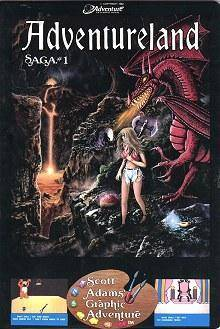Adventureland (video game)
 From Wikipedia the free encyclopedia
From Wikipedia the free encyclopedia
Adventureland is a text adventure video game for microcomputers,[1] released by Scott Adams in 1978. The game has no plot[2] but simply involves searching for thirteen lost artifacts in a fantasy setting. Its success led Adams to form Adventure International,[3] which went on to publish thirteen similar games in the Adventure series, each in different settings.
Gameplay
[edit]Adventureland is controlled through the use of written commands. These can consist of a single word, such as those used for player character movement, including north, south, east, west, up, and down. They can also take the form of simple, two-word verb/noun phrases, such as "climb tree". Although the game can recognize about 120 words, the parser only takes the first three letters into account.[4][5] This means not only that the parser occasionally misidentifies words, but also that commands can be truncated: "lig lam" would be interpreted as "light lamp".
In order to complete the game, the player has to collect the thirteen lost artifacts: A statue of Paul Bunyan's blue ox, Babe, jeweled fruit, golden fish, a dragon's egg, a golden net, a magic carpet, a diamond necklace, a diamond bracelet, a pot of rubies, "royal honey", a crown, a magic mirror, and a "firestone".[6]
Development
[edit]Adventureland, Adams' first program, was inspired by[7] the earlier Colossal Cave Adventure, though it is not on the same scale.[8] The source code for Adventureland was published in SoftSide magazine in 1980[9] and the database format was subsequently used in other interpreters such as Brian Howarth's Mysterious Adventures series.[10]

Adventureland was written for the TRS-80, then ported to other systems, most of which didn't exist in 1978: Apple II, Atari 8-bit computers, TI-99/4A, PET, VIC-20, Commodore 64, IBM PC, ZX Spectrum, BBC Micro, Acorn Electron, Dragon 32/64, and Exidy Sorcerer. A cut-down, three treasure version entitled Adventure 0: Special Sampler was also sold at a lower price.[11]
In 1982, Adventureland was re-released with graphics, thus enabling the player to view visible representations of the scenery and objects.[12][13]
Reception
[edit]Mark Herro for Dragon commented that "I can't recommend ANY version of Scott Adams' Adventure series highly enough. Beg, borrow, or steal a chance to play Adventure!"[8] British print magazine Micro Adventurer praised the VIC-20 version was released as a cartridge as the loading times would be too long otherwise. The screen format and parser were "standard" according to the magazine. It criticized minor controlling features, the non-consistent map and the seemingly random placement of treasures.[14] InfoWorld's Essential Guide to Atari Computers recommended the game as "the best of the early" adventures.[15]
References
[edit]- ^ Griffin, Brad (March–April 1983). "Scott Adams Adventures 1–12". ANALOG Computing (10). Archived from the original on 3 March 2016. Retrieved 13 April 2015.
- ^ Adventure No. 01 - Adventureland v3.9-416 (1981)(Adventure International) https://archive.org/details/Adventure_No._01_Adventureland_v3.9-416_1981_Adventure_International
- ^ "Game Set Interview: Adventure International's Scott Adams" Archived 3 August 2016 at the Wayback Machine, Game Set Watch, July 19th, 2006, retrieved on April 20, 2009
- ^ Adventure No. 01 - Adventureland v3.9-416 (1981)(Adventure International) https://archive.org/details/Adventure_No._01_Adventureland_v3.9-416_1981_Adventure_International
- ^ "Great Scott". GamesTM. No. 88. 2009. pp. 152–157.
- ^ Adventure No. 01 - Adventureland v3.9-416 (1981)(Adventure International) https://archive.org/details/Adventure_No._01_Adventureland_v3.9-416_1981_Adventure_International
- ^ Dennis G. Jerz, Somewhere Nearby is Colossal Cave: Examining Will Crowther's Original “Adventure” in Code and in Kentucky, http://www.digitalhumanities.org/dhq/vol/001/2/000009/000009.html
- ^ a b Herro, Mark (October 1980). "The Electric Eye" (PDF). Dragon. Vol. 5, no. 4. TSR Hobbies, Inc. pp. 42–43. Retrieved 11 July 2015.
Then along came Scott Adams, who converted ADVENTURE for use with home computers. His first program, ADVENTURELAND, is a slightly scaled-down, machine-language version of the 'original' ADVENTURE program. Then he came out with PIRATE ADVENTURE, which has a completely different plot. With the success of these two programs, Scott wrote even more, and he has now become the acknowledged 'king' of the ADVENTURE game, with ten different versions being marketed. And there is talk of more on the way! ...During a game, the computer's video screen in divided into two parts. The upper half of the screen always displays the description of the location the player is in at the moment. It also lists the obvious directions the player may go (there may be other exits, such as climbing a tree if in a forest, or entering a specific location). The bottom half of the screen is reserved for the player's input, such as giving commands. ...there is very little bloodshed of any kind in the Adams ADVENTURE series. It's brain instead of brawn that counts here. Indeed, there are many funny occurrences ...I can't recommend ANY version of Scott Adams' ADVENTURE series highly enough. Beg, borrow, or steal a chance to play ADVENTURE!!!!!
- ^ Adams, Scott (July 1980). "Adventureland". SoftSide. p. 36. Retrieved 13 April 2015.
- ^ Graham, Nelson (2001). The Inform Designer's Manual (PDF). Dan Sanderson. p. 358. ISBN 0-9713119-0-0.
- ^ 0:Adventureland Demo "Scott Adams Classic Adventures," (retrieved on May 4, 2009).
- ^ Virtually Real:being in cyberspace, M. Leigh, 2014, PHD thesis, https://figshare.utas.edu.au/articles/thesis/Virtually_real_being_in_cyberspace/23242163, p 22
- ^ "Scott Adams Classic Adventures", Adventureland, retrieved April 20, 2009
- ^ "Thanks for the memory". Micro Adventurer. 1 November 1983. p. 19.
- ^ Mace, Scott (1984). InfoWorld's Essential Guide to Atari Computers. Harper & Row. pp. 77–78. ISBN 978-0-06-669006-3.
External links
[edit]- "Adventureland game walkthrough part 1 commodore 64 version." YouTube, 15 February 2013, accessed 31 October 2020
- Adventureland (video game) in the Interactive Fiction Database
